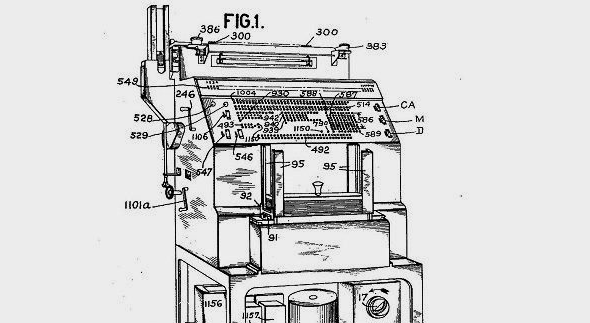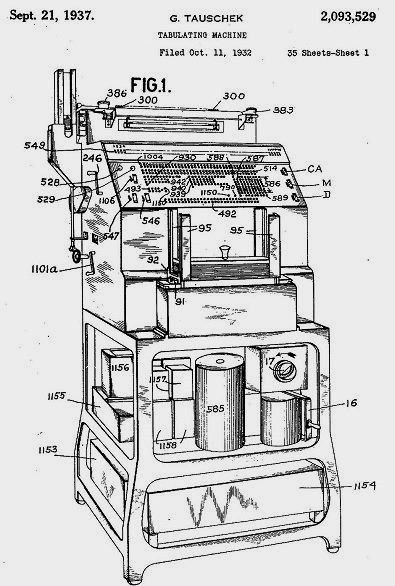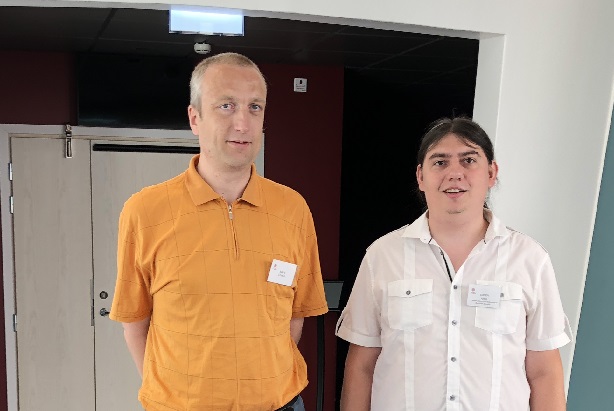Gustav Tauschek (1899-1945) war ein genialer Erfinder, der seine Entwicklungen jedoch nie in wirtschaftlichen Erfolg ummünzen konnte. Blogleser Eugen Antal hat Hinweise darauf gefunden, dass Tauschek im Zweiten Weltkrieg auch eine Verschlüsselungsmaschine erfunden hat.
English version (translated with Deepl)
“Vermutlich war er der ideenreichste Kopf in der elektromechanischen Datenverarbeitung”, schrieb vor einem Jahr der Blog des Heinz Nixdorf Museumsforums (HNF) und fügte hinzu: “Die schlechte Nachricht ist, dass es keines seiner Konzepte auf den Markt schaffte.”
Die Rede ist von Gustav Tauschek, einem österreichischen Pionier der Informationstechnik, der zwischen 1922 und 1945 zahlreiche Verbesserungen für die damaligen Rechenmaschinen auf Lochkartenbasis entwickelte. Das folgende Bild zeigt einen Tabulator:
Ein Bild von Tauschek (zwischen dem Ingenieur Engelbert Reingruber und dem Physiker Josef Nagler im Jahr 1932) gibt es hier.
Die Tauschek-Verschlüsselungsmaschine
Der slowakische Krypto-Geschichtsexperte Eugen Antal, …
…, der unter anderem das Portal of Historical Ciphers betreibt, hat mich kürzlich auf eine interessante Sache aufmerksam gemacht. Er ist im Slowakischen Nationalarchiv in Bratislava auf Hinweise zu einer Verschlüsselungsmaschine gestoßen, die Gustav Tauschek gebaut hat. Leider gibt es nur wenige Informationen zu diesem Gerät. Vielleicht können meine Leser dazu beitragen, mehr herauszufinden.
Eugen hat drei Dokumente gefunden, die die eine Tauschek-Verschlüsselungsmaschine erwähnen. Alle drei stammen aus dem Jahr 1942. Es ist nicht vollkommen sicher, dass mit “Tauschek” tatsächlich der besagte Tüftler gemeint ist. Allerdings soll sich dieser laut dem besagten HNF-Artikel im Zweiten Weltkrieg in der Slowakei aufgehalten haben. Das würde passen. Außerem heißt es auf einer Webseite, die Eugen gefunden hat: “… he also invented an encryption machine, which operated on the mechanical basis and one which operated based on optical-electrical principle …” Auch das passt.
Aus urheberrechtlichen Gründen kann ich leider keine Scans der drei Dokumente in diesen Artikel präsentieren. Da die Unterlagen auf Slowakisch verfasst sind und keine Bilder enthalten, ist das allerdings nicht ganz so dramatisch. Dankenswerterweise hat Eugen alle drei Dokumente transkribiert und das erste auch übersetzt.
Dokument 1
Das erste Dokument (24. Juli 1942) ist eine Gebrauchsanweisung zu einem “Tauschek-Gerät”. Es trägt einen Stempel mit einer Aufschrift, die übesetzt lautet: “MECHANIKA – Slovakische Fabrik für Druckmessgeräte und Thermometer Bratislava”.
Hier ist Eugens Übersetzung ins Englische:
- Choose a password! As a precaution, it is better to create a password that consists of at least 6
letters, which do not form a meaningful word, e.g. UJSAKR. - Insert the pins into the bottom holes just below the letters of the selected password. Insert the pin
corresponding to the last letter of the password into the top hole below the appropriate letter. - Turn the pin corresponding to the first letter of the password with the pointer clockwise to the
stop of the lower half wheel. - Encryption: Find the first letter of the plaintext in the plain text alphabet (upper small disc) and
read the corresponding (opposite) letter from the lower larger disc (cipher alphabet). Turn the next
pin again to the stop and read the second letter of the text and continue in this way. If the upper pin
is turned to the stop, turn the next lower pin to the stop, and read the letter at that position. - Decryption : Set the machine to its original position, in such a way that under each letter of the
chosen password there is a pin in the lower holes and only for the last letter of the password is a pin
in the upper hole. Turn the pin of the first letter of the password to the stop and search for the
corresponding letter in the cipher text alphabet, and read the letter opposite in the plain text
alphabet. Continue in this way.
Important notes
If one pin is on top of the second, we must first turn the upper pin to the stop, then turn the lower
pin to the stop, and only then read the letter. The words can be separated by less frequently used letters like X. The word “ Stop” can be used instead of a full stop. Both letters and numbers can be selected for encryption. The process is the same.
Dokument 2
Dieses Dokument ist ein Schreiben des Innenministeriums vom 26. Mai 1942, das die Bestellung eines “Tauschek-Geräts” erwähnt:
Encryption devices for the state police, order number: 21207/42 dated 15.IV.1942.
Attachments: 1 device and 1 offer.
Headquarters of the Police Directorate in Bratislava and one for the State Police Office in Žilina. After ordering and delivery, send the mentioned device to the named office opposite the confirmation. Have these devices consistently entered into the inventory. For the correctness of the execution.
Head of the presidency: Babčan v.r. Police Directorate in Bratislava
Dokument 3
Dieses Dokument stammt vom Polizeipräsidium in Bratislava und ist auf den 24. Juli 1942 datiert. Es könnte sich um einen Lieferschein für ein “Tauschek-Gerät” handeln.
- Encryption keys for the state Confidential! Police delivery.
- Mr. Police Director in Prešov,
- Mr. Head of the State Police Office in Žilina.
According to the attached depreciation of the decree of the Presidium of the Ministry of the Interior of 26 May 1942 no. 12-2070 / 2-1942 I am enclosed with:
- Bronze encryption key, “Tauschek” system, with leather case and with 15 pins, and
- Instructions for using the same encryption key.
At the same time, I request that the attached certificate be filled in, signed and returned so that I can comply with the 2nd and 3rd paragraphs of the cited decree of the Presidium of the Ministry of the Interior. The encryption key was purchased for the amount of 296.- Ks. The mentioned encryption key will be especially important in the planned construction of a police radiotelegraph network, for which the program for the determination of changeable secret encryption passwords will be issued by the Presidium of the Ministry of the Interior to all addressed authorities.
Police Director
Was für eine Verschlüsselungsmaschine war das Tauschek-Gerät?
Den drei Dokumenten zufolge muss es das Tauschek-Gerät als marktreifes Produkt (und nicht etwa nur als Prototypen oder Entwurf) gegeben haben.
Ich würde nun gerne mehr über dieses Gerät herausfinden. Eugen Antal hat mir folgendes geschrieben: “It looks like it is a polyalphabetic cipher machine. Based on the two cipher discs I guess it is something like the Kryha, where pins are used to arrange the plain text/cipher text alphabets based on a password. Without further information (details about the discs) it is hard to tell if the pins provide just a Caesar shift of the alphabet, or if the pins provide a shift on an already permuted alphabet. In my English translation I’ve used the cipher alphabet notation for the large disc, but in the original document it is as “rozhádzaná abeceda” what can be interpreted also as a ‘scattered alphabet’.”
Gustav Tauschek soll insgesamt 169 Patente an IBM verkauft haben. Tatsächlich findet man auf Google Patents zahlreiche Patente von ihm, doch keines davon betrifft eine Verschlüsselungsmaschine. Auch das Buch United States Cryptographic Patents, 1861-1989 von Jack Levine nennt Tauschek nicht.
Es gibt ein Buch mit dem Titel Gustav Tauschek und seine Maschinen, das leider vergriffen ist.
Kann jemand mehr zu diesem Gerät sagen? Über Hinweise würde ich mich freuen.
Follow @KlausSchmeh
Further reading: Virtueller Nachbau einer Verschlüsselungmaschine, die nie gebaut wurde
Linkedin: https://www.linkedin.com/groups/13501820
Facebook: https://www.facebook.com/groups/763282653806483/





Kommentare (5)